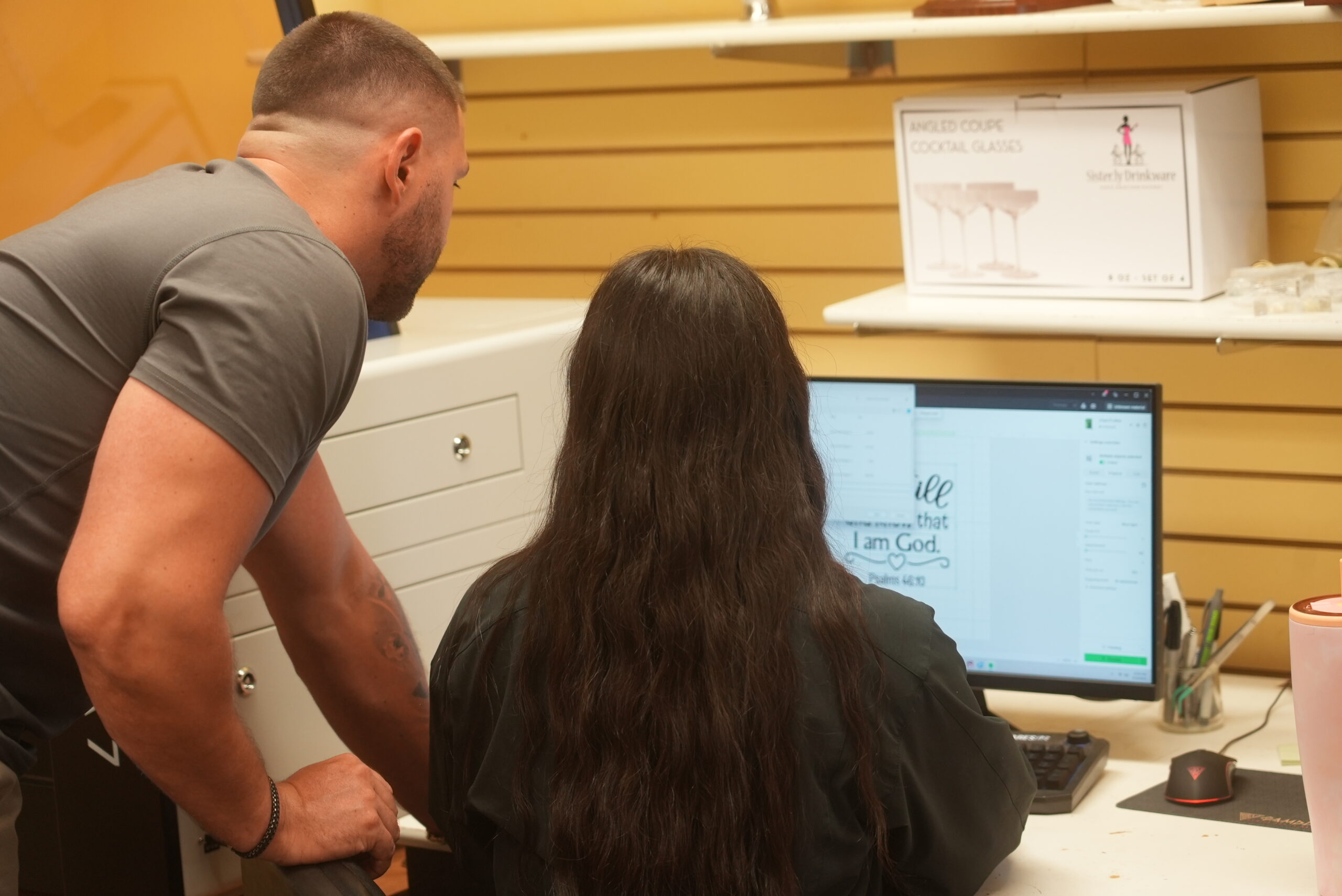Running a retail business means wearing many hats.
At Awards & Engraving, a trusted shop in Libertyville, Illinois, known for custom trophies, signage, and personalized gifts, owner Daniel Mattson has learned that mastering time management is essential to keeping things running smoothly year after year.
With smart customer service and creative design skills, Daniel has developed strategies for juggling the demands of retail entrepreneurship.
If you’re a current or aspiring store owner, these seven tips will help you sharpen your retail time management skills and keep your business running smoothly without losing sight of why you started.
1. Learn By Doing
When Daniel and his wife were considering purchasing Awards & Engraving, they approached the transition with intentionality. Rather than jumping in blindly, Daniel spent six weeks shadowing the former owner, working three to four days a week. During that time, he was actively observing him, learning how to fulfill orders, interact with customers, operate machinery, and manage the shop’s daily workflow.
What made this hands-on experience unique was his dual focus: understanding the technical side of the business while also evaluating whether it would be a good fit for their lifestyle and long-term goals.
Before taking on a retail business, embed yourself in the day-to-day operations if possible. Use this time to map out essential tasks, spot inefficiencies, and determine what you can streamline or delegate. It’s a foundational step toward effective retail time management.
2. Prioritize Emotional Connection
For most retailers, managing inventory, production schedules, and customer orders can lead to a transactional mindset. Daniel does things differently.
He treats every project as if it were his own. You might find him engraving a cake knife for newlyweds, customizing a retirement award for a beloved principal, or producing 150 plaques for a local school district. Still, no matter the task, he handles it with attention, patience, and care. His workflow is intentionally built around listening first, collaborating on design, and finally moving into production and delivery.
This method is part of what makes his turnaround time and reputation so strong.
Here’s how he makes emotional service efficient:
- Start with curiosity: He asks customers why the item matters to them to frame the design conversation with purpose.
- Honor the story: He asks questions that draw out meaning, like “What do you want this gift to say without words?”
- Work within emotions: Daniel notes that for many customers, these items mark significant life events, like weddings, retirements, and memorials, so he manages time around the emotional impact.
Excellent retail time management is about building processes that make space for empathy. By understanding your customer’s emotional needs upfront, you’ll save time on revisions while also building lasting relationships.

3. Structure Creative Collaboration
Designing awards, plaques, and personalized gifts is a technical task that requires a creative process full of both inspiration and precision. At Awards & Engraving, Daniel doesn’t leave creativity to chance. Instead, he builds structured time into his schedule for collaborative design sessions with customers.
These sessions aren’t rushed or one-sided. Daniel sits down with each customer, often in real time, and guides them through the creative journey. He asks clarifying questions, shares digital mockups on the spot, and invites customers into the process so they feel ownership of the final product.
This open dialogue is a clever use of time. By aligning early on design expectations, Daniel reduces the risk of costly do-overs and gets faster approvals.
As he puts it, “I like to take what the customer is giving me feedback on and bringing that to the point where I’m going to give you exactly what you want. I’m going to listen to you and I’m going to give you my best ideas, but I want your ideas to be the final one.”
This mindset transforms each project from a generic order into something thoughtful, and it happens within a well-managed schedule.
As a retailer, you should schedule creative blocks into your calendar so innovation becomes a consistent part of your workflow. Creating a structured approach to creative work is a powerful way to master retail time management.
4. Apply Lessons from Past Roles
Before stepping into the world of custom engraving, Daniel had already worn multiple entrepreneurial hats, including running a gym and working in HVAC. These experiences taught him how to manage time under pressure, juggle competing priorities, and stay calm in customer-facing situations.
Those lessons didn’t disappear when he took over Awards & Engraving: they translated seamlessly. Daniel’s been able to draw on his background to move fluidly between service, sales, and operations. His ability to anticipate workflow bottlenecks, communicate clearly, and stay focused under pressure is a direct result of those earlier chapters in his career.
Think about how you can leverage your past jobs and hobbies to guide how you approach task management, team leadership, or customer service. Your experience outside of retail can be a powerful asset for better retail time management.

5. Front-Load Customer Interactions
Daniel has learned that some of the most time-consuming parts of retail happen after the customer walks out the door. To minimize follow-ups and rework, he uses a visual-first workflow that focuses on real-time design and clarity.
He makes sure that the vision is clear, agreed upon, and nearly final before production ever begins. This method saves hours of back-and-forth and significantly reduces production delays.
Learn the steps Daniel takes:
- He brings a laptop or tablet onto the sales floor so design becomes part of the initial conversation.
- He mocks up the design live, incorporating the customer’s preferences as they speak. This keeps them engaged and confident in the process.
- He allows time for collaborative tweaks while the customer is still engaged and decision-focused.
Front-load your customer interactions with visuals and details to reduce follow-ups and rework later. This way, you save time and build trust immediately.
6. Establish Seasonal Systems
At Awards & Engraving, Daniel’s business is highly seasonal. He handles large-volume orders tied to school calendars, sports seasons, holidays, and community events, and each season brings a unique spike in demand.
Because of this, Daniel doesn’t manage time strictly on a day-to-day basis; instead, he thinks in cycles. He anticipates inventory needs and production bandwidth required based on when rushes will come. That way, he can prepare accordingly. This forward-thinking approach allows him to stay ahead of deadlines, reduce last-minute pressure, and deliver consistently.
Daniel’s ability to flex his schedule based on predictable community needs is a critical part of his success and a major contributor to his efficient time management in retail.
Review your business calendar annually to identify high-traffic windows and adjust workflows accordingly. Seasonal planning is essential for managing your time effectively as a retailer.

7. Align Personal Values with Your Business Structure
For Daniel, owning Awards & Engraving is about serving a community he’s deeply connected to. He lives just four blocks from the shop, attends church nearby, and frequently works with local schools, churches, and families that he’s known for years. His proximity to the business is a key factor in how he integrates his personal and professional life in a way that reflects his values.
This alignment allows him to be present in his work and community. He’s able to stop in the shop outside of hours when needed, deliver items to local clients, and build strong relationships. That closeness also saves time otherwise lost in commuting, scheduling around distant suppliers, or juggling disconnected priorities.
While not a traditional “time management” tactic, this approach reduces stress, allowing Daniel to spend more time doing what matters most, including listening to his customers, refining his designs, and growing a meaningful business at a sustainable pace.
When you can easily commute to your business, managing your time feels less like a balancing act and more like alignment.
Conclusion
Retail success requires some hustle, but it also takes strategic thinking, emotional intelligence, and time mastery. By studying the approach of Daniel Mattson and Awards & Engraving, one thing becomes clear: great retail time management isn’t about doing everything. It’s imperative to focus on doing the right things, the right way, at the right time.
Want more insights from local retail owners? Explore more stories on We Are Retail and discover how others are finding balance, purpose, and success.




